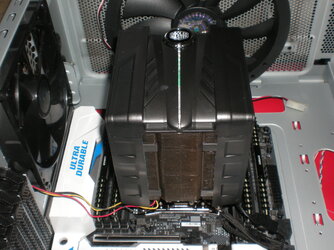hi
this is my first time building power pc, and am confused between AIO or air cooling as both has ups and downs.
I've gone through many reviews but still not sure what to take. I know it depends on the preference but I think more clarification would help.
Am building AMD Ryzen 1800X
case Zalman n11 neo, with 8 fans
GPU 1080 TI
Motherboard : GIGABYTE AX370 Gaming K7
I want to chose between on of these :
1- noctua nh-d15 se-am4
2- EKWB EK-XLC Predator 240
What make me confused, as much as I prefer the air as its more safe but I was thinking
the size of the Noctua, isn't gonna be a problem for air flow which may make it hot inside the case? also it will be so close to the GPU , the hot air going out of it will go directly
to the heat sink, is this gonna effect anything?
one last think , the weight, it weight 1.3 kg with both fans installed , is this gonna damage the motherboard in long term?
about liquid cooling, everything seems great, specially with the hi
this is my first time building power pc, and am confused between AIO or air cooling as both has ups and downs.
I've gone through many reviews but still not sure what to take. I know it depends on the preference but I think more clarification would help.
Am building AMD Ryzen 1800X
case Zalman n11 neo, with 8 fans
GPU 1080 TI
Motherboard : GIGABYTE AX370 Gaming K7
I want to chose between on of these :
1- noctua nh-d15 se-am4
2- EKWB EK-XLC Predator 240
What make me confused, as much as I prefer the air as its more safe but I was thinking
the size of the Noctua, isn't gonna be a problem for air flow which may make it hot inside the case? also it will be so close to the GPU , the hot air going out of it will go directly
to the heat sink, is this gonna effect anything?
one last think , the weight, it's 1.3 kg with both fans installed, is this gonna damage the motherboard in long term?
on the other hand , liquid cooling sounds great in performance ,the EKWB EK-XLC Predator 240 does amazing job, there is no size problem, no weight problem.
But it has the maintenance problem, the water pump , the leakage.
am not saying any of these will happen, but there is a possibility , any failure may cause big damage for the system.
I know this question has been asked many times, and there is no exact answer, but hope to find here better guidance.
Regards
this is my first time building power pc, and am confused between AIO or air cooling as both has ups and downs.
I've gone through many reviews but still not sure what to take. I know it depends on the preference but I think more clarification would help.
Am building AMD Ryzen 1800X
case Zalman n11 neo, with 8 fans
GPU 1080 TI
Motherboard : GIGABYTE AX370 Gaming K7
I want to chose between on of these :
1- noctua nh-d15 se-am4
2- EKWB EK-XLC Predator 240
What make me confused, as much as I prefer the air as its more safe but I was thinking
the size of the Noctua, isn't gonna be a problem for air flow which may make it hot inside the case? also it will be so close to the GPU , the hot air going out of it will go directly
to the heat sink, is this gonna effect anything?
one last think , the weight, it weight 1.3 kg with both fans installed , is this gonna damage the motherboard in long term?
about liquid cooling, everything seems great, specially with the hi
this is my first time building power pc, and am confused between AIO or air cooling as both has ups and downs.
I've gone through many reviews but still not sure what to take. I know it depends on the preference but I think more clarification would help.
Am building AMD Ryzen 1800X
case Zalman n11 neo, with 8 fans
GPU 1080 TI
Motherboard : GIGABYTE AX370 Gaming K7
I want to chose between on of these :
1- noctua nh-d15 se-am4
2- EKWB EK-XLC Predator 240
What make me confused, as much as I prefer the air as its more safe but I was thinking
the size of the Noctua, isn't gonna be a problem for air flow which may make it hot inside the case? also it will be so close to the GPU , the hot air going out of it will go directly
to the heat sink, is this gonna effect anything?
one last think , the weight, it's 1.3 kg with both fans installed, is this gonna damage the motherboard in long term?
on the other hand , liquid cooling sounds great in performance ,the EKWB EK-XLC Predator 240 does amazing job, there is no size problem, no weight problem.
But it has the maintenance problem, the water pump , the leakage.
am not saying any of these will happen, but there is a possibility , any failure may cause big damage for the system.
I know this question has been asked many times, and there is no exact answer, but hope to find here better guidance.
Regards
